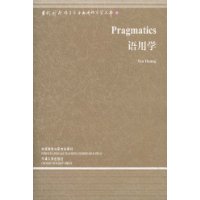《语用学》一书作者对语用学与句法学以及语义学的界面进行研究,为我们展现出了一幅比较完整的语用学研究图景。全书见解独到、内容新颖,是一部优秀的语用学教科书。本书作者黄衍早年留学英国,师从著名语用学家Stephen C.Levinson,获剑桥大学博士学位,后再获牛津大学博士学位,并曾在这两所大学及雷丁大学执教。黄衍现为新西兰奥克兰大学语言学及应用语言学系教授。
Preface
Acknowledgements
Symbols and abbreviations
1. Introduction
1.1. What is pragmatics?
1.1.1. Adefinition
1.1.2. A brief history of pragmatics
1.1.3. Two main schools of thought in pragmatics: Anglo-American versus European Continental
1.2. Why pragmatics?
1.2.1. Linguistic underdeterminacy
1.2.2. Simplification of semantics and syntax
1.3. Some basic notions in semantics and pragmatics
1.3.1. Sentence, utterance, proposition
1.3.2. Context
1.3.3. Truth value, truth condition, entailment
1.4. Organization of the book
Key concepts
Exercises and essay questions
Further readings
Part Ⅰ Central topics in pragmatics
2. Implicature
2.1. Classical Gricean theory of conversational implicature
2.1.1. The co-operative principle and the maxims of conversation
2.1.2. Relationship between the speaker and the maxims
2.1.3. Conversational implicatureo versus conversational implicature
2.1.4. Generalized versus particularized conversational implicature
2.1.5. Properties of conversational implicature
2.2. Two neo-Gricean pragmatic theories of conversational implicature
2.2.1. The Hornian system
2.2.2. The Levinsonian system
2.3. Conventional implicature
2.3.1. What is conventional implicature?
2.3.2. Properties of conventional implicature
2.4. Summary
Key concepts
Exercises and essay questions
Further readings
3. Presupposition
3.1. What is presupposition?
3.2. Properties of presupposition
3.2.1. Constancy under negation
3.2.2. Defeasibility
3.2.3. The projection problem
3.3. Analyses
3.3.1. The filtering-satisfaction analysis
3.3.2. The cancellation analysis
3.3.3. The accommodation analysis
3.4. Summary
Key concepts
Exercises and essay questions
Further readings
4. Speech acts
4.1. Performativesversus constatives
4.1.1. The performative/constative dichotomy
4.1.2. The performative hypothesis
4.2. Austin's felicity conditions on performatives
4.3. Locutionary, illocutionary, and perlocutionary speech acts
4.4. Searle's felicity conditions on speech acts
4.5. Searle's typology of speech acts
4.6. Indirect speech acts
4.6.1. What is an indirect speech act?
4.6.2. How is an indirect speech act analysed?
4.6.3. Why is an indirect speech act used? Some remarks on politeness
4.7. Speech acts and culture
4.7.1. Cross-cultural variation
4.7.2. Interlanguage variation
4.8. Summary
Key concepts
Exercises and essay questions
Further readings
5. Deixis
5.1. Preliminaries
5.1.1. Deictic versus non-deictic expression
5.1.2. Gestural versus symbolic use of a deictic expression
5.1.3. Deictic centre and deictic projection
5.2. Basic categories of deixis
5.2.1. Person deixis
5.2.2. Time deixis
5.2.3. Space deixis
5.3 Other categories of deixis
5.3.1. Social deixis
5.3.2. Discourse deixis
5.4. Summary
Key concepts
Exercises and essay questions
Further readings
Part Ⅱ Pragmatics and its interfaces
6. Pragmatics and cognition: relevance theory
6.1. Relevance
6.1.1. The cognitive principle of relevance
6.1.2. The communicative principle of relevance
6.2. Explicature, implicature, and conceptual versus procedural meaning
6.2.1. Grice: what is said versus what is implicated
6.2.2. Explicature
6.2.3. Implicature
6.2.4. Conceptual versus procedural meaning
6.3. From Fodorian 'central process' to submodule of 'theory of mind'
6.3.1. Fodorian theory of cognitive modularity
6.3.2. Sperber and Wilson's earlier position: pragmatics as Fodorian 'central process'
6.3.3. Sperber and Wilson's current position: pragmatics as submodule of'theory of mind
6.4. Relevance theory compared with classical/neo-Gricean theory
6.5. Summary
Key concepts
Exercises and essay questions
Further readings
7. Pragmatics and semantics
7.1. Reductionism versus complementarism
7.2. Drawing the semantics-pragmatics distinction
7.2.1. Truth-conditional versus non-truth-conditional meaning
7.2.2. Conventional versus non-conventional meaning
7.2.3. Context independence versus context dependence
7.3. Pragmatic intrusion into what is said and the semantics-pragmatics interface
7.3.1. Grice: what is said versus what is implicated revisited
7.3.2. Relevance theorists: explicature
7.3.3. Recanati: the pragmatically enriched said
7.3.4. Bach: conversational impliciture
7.3.5. Can explicature/the pragmatically enriched said/impliciture be distinguished from implicature?
7.3.6. Levinson: conversational implicature
7.3.7. The five analyses compared
7.4. Summary
Key concepts
Exercises and essay questions
Further readings
8. Pragmatics and syntax
8.1. Chomsky's views about language and linguistics
8.2. Chomsky's binding theory
8.3. Problems for Chomsky's binding theory
8.3.1. Binding condition A
8.3.2. Binding condition B
8.3.3. Complementarity between anaphors and pronominals
8.3.4. Binding condition C
8.4 A revised neo-Gricean pragmatic theory of anaphora
8.4.1. The general pattern of anaphora
8.4.2. A revised neo-Gricean pragmatic apparatus for anaphora
8.4.3. The binding patterns
8.4.4. Beyond the binding patterns
8.4.5. Logophoricity and emphaticness/contrastiveness
8.5. Theoretical implications
8.6. Summary
Key concepts
Exercises and essay questions
Further readings
Glossary
References
Suggested solutions to exercises
Index of names
Index of languages, language families, and language areas
Index of subjects
1.1.3. Two main schools of thought in pragmatics:
Anglo-American versus European ContinentalAs pointed out in Huang (2001a), two main schools of thought can beidentified in contemporary pragmatics: Anglo-American and EuropeanContinental. Within the former conception of linguistics and the philoso-phy of language, pragmatics is defined as the systematic study of meaningby virtue of, or dependent on, language use. The central topics of inquiryinclude implicature, presupposition, speech acts, and deixis (see 1.1 above).This is known as the component view of pragrnatics, namely, the view thatpragmatics should be treated as a core component of a theory of language,on a par with phonetics, phonology, morphology, syntax, and semantics.By contrast, other areas such as anthropological linguistics, applied lin-guistics, and psycholinguistics would lie outside this set of core compon-ents. Within the Continental tradition, pragmatics is defined in a farbroader way, encompassing much that goes under the rubric of sociolin-guistics, psycholinguistics, and discourse analysis. Witness, for example,Verschueren's (1999: 7, 11) definition that 'pragmatics constitutes a generalfunctional (i.e. cognitive, social and cultural) perspective on linguisticphenomena in relation to their usage in the form of behaviour'. Thisrepresents the perspective view of pragmatics, namely, the view that prag-matics should be taken as presenting a functional perspective on everyaspect of linguistic behaviour. More or less the same is true of the definitionof pragmatics provided within the former Soviet and East European trad-ition. Under this approach, pragmatics (called pragmalinguistics) is ingeneral conceived of as a theory of linguistic communication, includinghow to influence people through verbal messages (Prucha 1983).
装 帧:平装
页 数:346
版 次:1
开 本:16开
纸 张:胶版纸
正文语种:英语

